January 2025
The global medical foods market size is calculated at USD 26.07 billion in 2025 and is forecasted to reach around USD 40.74 billion by 2034, accelerating at a CAGR of 5.09% from 2025 to 2034. The North America medical foods market size surpassed USD 7.94 billion in 2024 and is expanding at a CAGR of 5.13% during the forecast period. The market sizing and forecasts are revenue-based (USD Million/Billion), with 2024 as the base year.
The global medical foods market size was estimated at USD 24.80 billion in 2024 and is predicted to increase from USD 26.07 billion in 2025 to approximately USD 40.74 billion by 2034, expanding at a CAGR of 5.09% from 2025 to 2034. The primary reasons behind the growth of this market are a rise in the number of chronic diseases and the geriatric population.
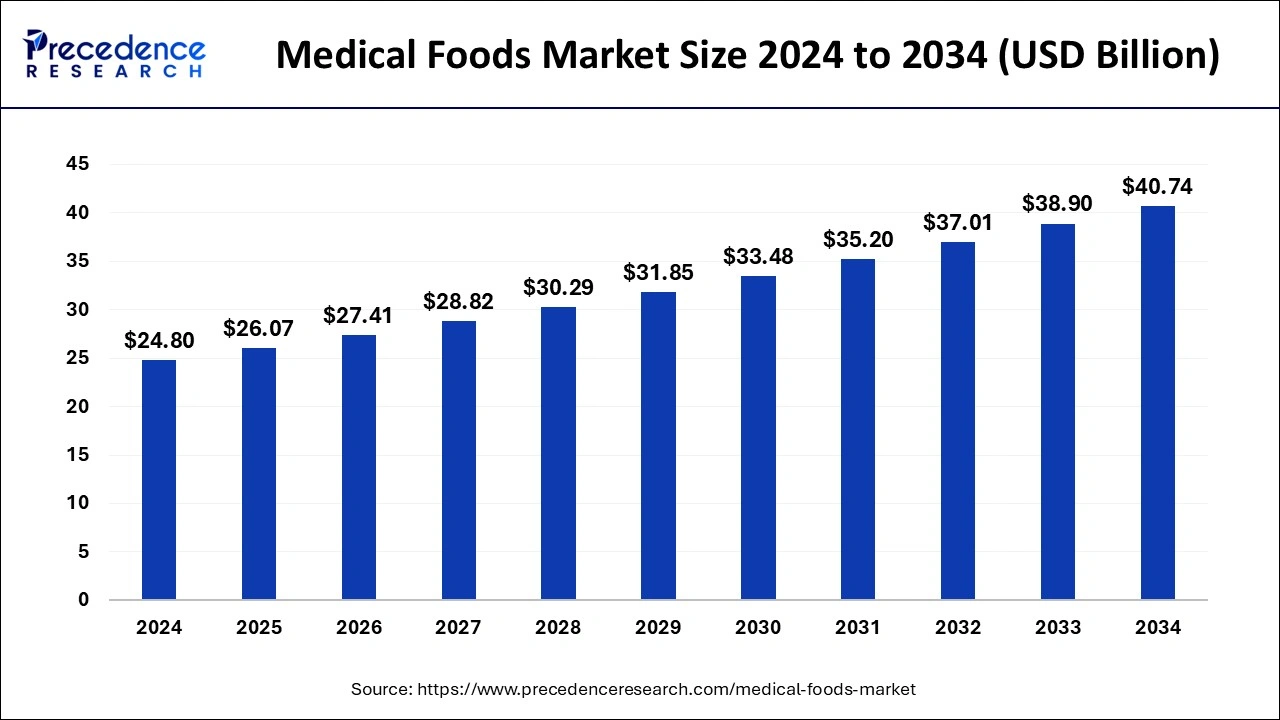
The U.S. medical foods market size reached USD 6.35 billion in 2024 and is predicted to be worth around USD 10.51 billion by 2034, at a CAGR of 5.17% from 2025 to 2034.
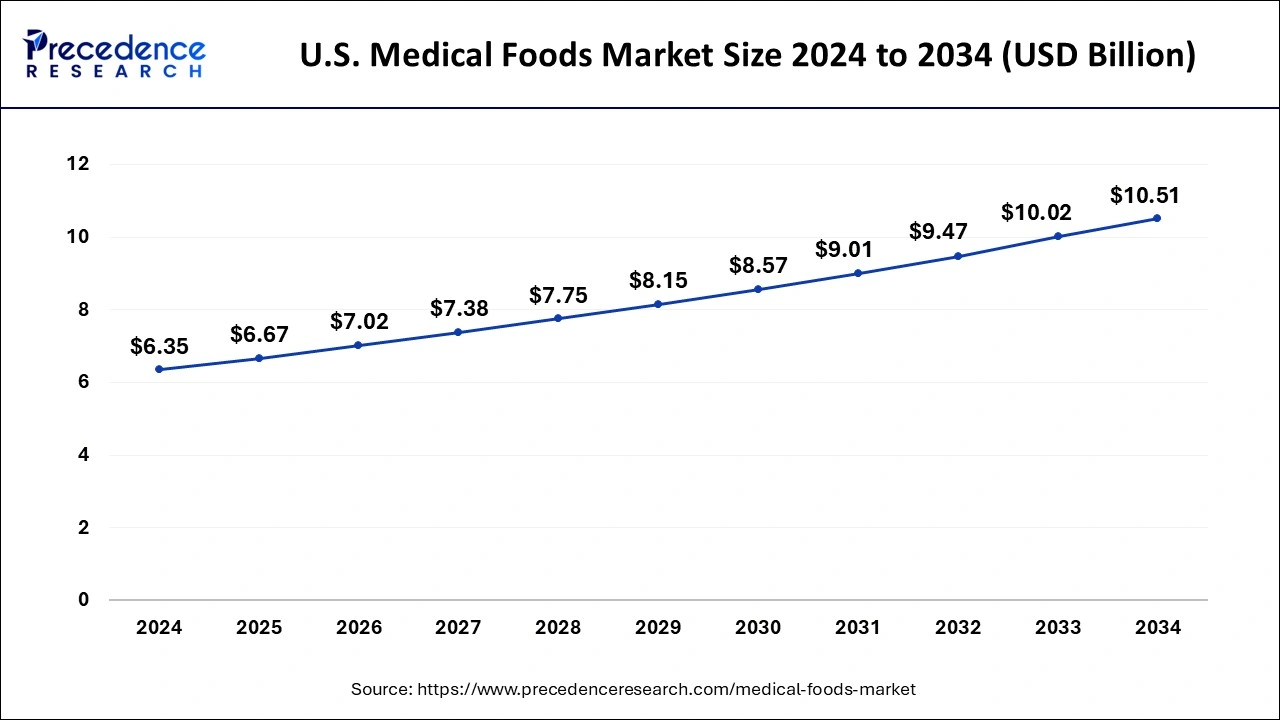
North America dominated the global medical foods market in 2024. The reason behind the dominance of North America is an increased geriatric population suffering from chronic diseases. A large number of people show their dependency on medical foods. There is a rise in the number of infants, too. It is anticipated that there will be a significant growth in population in the coming years. Chronic diseases in a large population are also showing nutritional deficiencies. Several people are suffering from neural disorders. Due to this, there will be a growth in the North American medical foods market.
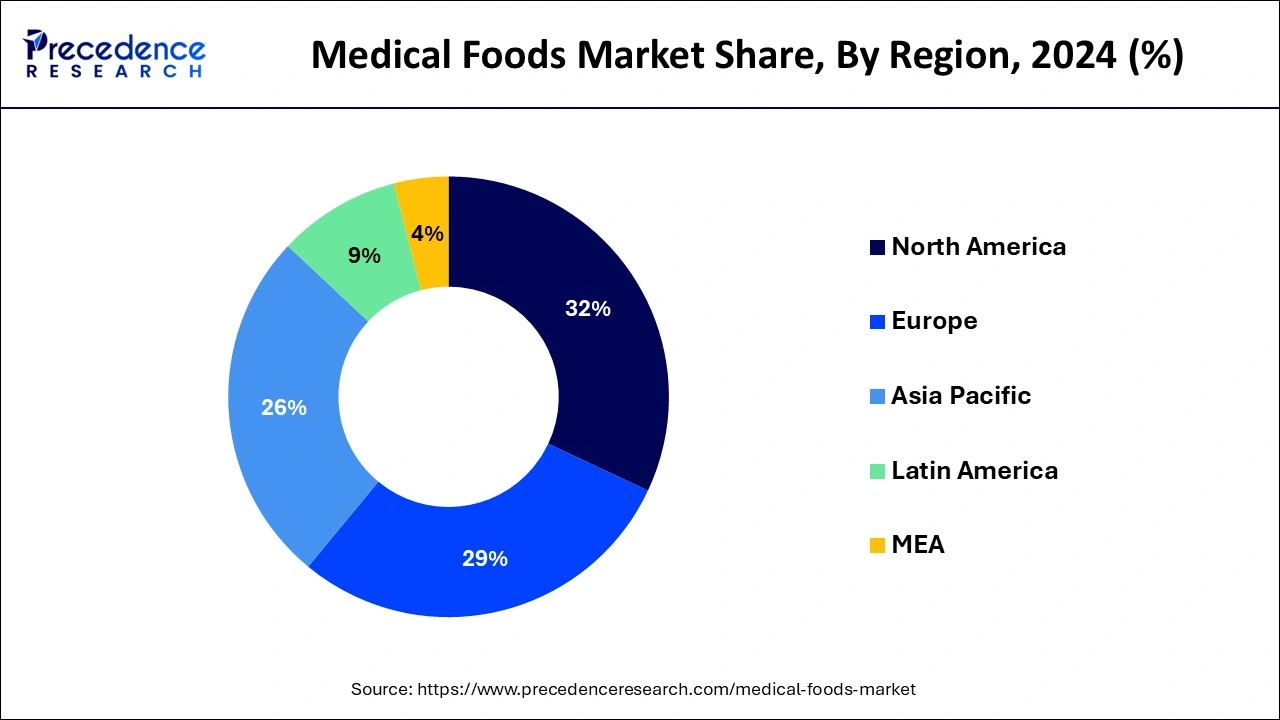
Asia Pacific will be the fastest-growing region in the global medical foods market during the projected period. There are increasing cases of cancer and diabetes, and the government is introducing many policies to develop the healthcare sector. There is a constantly growing geriatric population that is becoming more susceptible to diseases. People have caught a sedentary lifestyle because of joining corporate jobs. There is an awareness about health at the same time, and people are taking steps towards a healthier lifestyle. Medical foods are not only used for curing diseases but also to prevent them. There is strong competition among the local players, and this is leading to growth in the market.
When a person catches some disease, the disease demands certain nutritional requirements. The nutritional requirements might not be fulfilled by a normal diet. Hence, to fulfill these requirements, it is important to consume medical foods that have the necessary nutrition. Medical foods are orally ingested or fed using a tube. They are labeled for fulfilling the dietary requirements for specific diseases or conditions. They are only consumed under medical supervision.
Medical foods can be thought to be a hybrid of drugs and dietary supplements that are given in a regulated manner. Medical foods are labeled for specific medical conditions like Alzheimer's, Parkinson's, etc. Medical foods are useful in treating chronic diseases and help manage nutrition. Doctors can recommend medical foods after checking the overall nutritional intake and health of the patient. The main difference between nutritional supplements and medical foods is that medical foods need to undergo different phases of trials for pharmaceutical drugs. The disease or condition for which the foods are designed should be addressed properly in the case of medical foods.
| Report Coverage | Details |
| Growth Rate from 2025 to 2034 | CAGR of 5.09% |
| Global Market Size in 2025 | USD 26.07 Billion |
| Global Market Size by 2034 | USD 40.74 Billion |
| Largest Market | North America |
| Base Year | 2024 |
| Forecast Period | 2025 to 2034 |
| Segments Covered | By Route of Administration, By Product, By Application, and By Sales Channel |
| Regions Covered | North America, Europe, Asia-Pacific, Latin America, and Middle East & Africa |
Rising prevalence of chronic diseases
The primary drivers behind the medical foods market are a rising number of diseases and chronic disorders. Due to an unhealthy lifestyle, a huge population is ignoring their health today. Due to this, there are several patients struggling with diabetes, cancer, cardiovascular diseases, etc. There is a growing geriatric population, and with rising age, immunity gets reduced, and a person becomes more susceptible to diseases. For such a susceptible population, there have been several advancements in healthcare facilities. Awareness of health has increased among the population, and there is an increased market demand for nutritional products. There are more advancements in medicines, and people are aware of diet, too.
Challenges with clinical trials and maintaining nutritional quality
There are strict regulatory requirements and standards that have to be followed while manufacturing hinders the growth of the medical foods market. Preparing foods targeted to combat a particular disease and regulating the proper proportion of components accordingly can be challenging. There is limited awareness among people regarding medical foods, and many people, even in urban areas, don’t have much knowledge about them. Medical foods have a higher price because the preparation methods involve precisely monitored and tailored formulations of the foods. This makes the foods costly because they are formulated and tested by experts. However, high costs make them look like a luxury. There are other pharmaceutical alternatives that can create competition in the medical foods market. In many diseases, patients lose their taste and can find the food to be unappealing. However, not eating food might also not be good for one's health. So, the foods also need to be given a proper taste using proper flavors while keeping in mind that the flavors are not causing any harm to the patient's health.
Patients can ‘enjoy’ having their medicines.
Medical foods are a very effective way of treating the diseases. Many patients hate the taste of medicines, or taking too many medicines sounds daunting. In such cases, medical foods can help such patients by being medicines in disguise. This is particularly helpful for kids who don’t take their medicines, and such medical foods can also be helpful for pets. Medical food companies can add good flavors to the food and make it tastier and healthier for patients who have lost their appetite. The market can be expanded to different countries where the economies are flourishing, and people can afford high-quality healthcare.
According to the route of administration, the oral segment led the medical foods market in 2024 and is projected to maintain its position throughout the forecast period. In many cases, oral intake is functional in a patient, and it gives a feeling of ‘having eaten’ something. It also gives the patients the feeling that their condition is not that bad. Many times, the mental state of a patient helps them fight a disease. Medical foods can nourish the body well, and food absorption happens through the natural route. Oral intake is completely noninvasive, and hence, it is favored a lot. Oral medical foods are cost-effective as well.
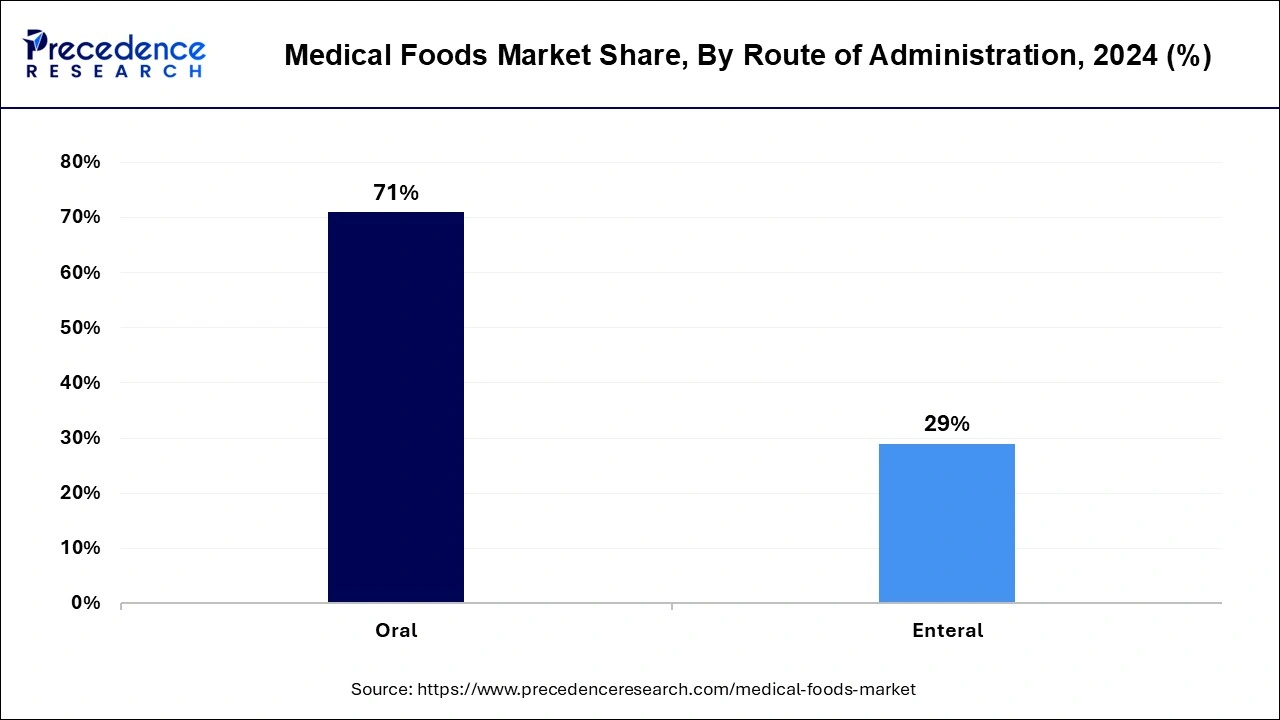
According to the route of administration, the enteral segment is expected to witness the fastest growth in the medical foods market over the forecast years. The enteral route is for patients with serious health issues who have completely lost the ability to consume food orally. Patients lose the sense of appetite when sick, and in such cases where oral intake is impossible, food has to be provided through the enteral route.
According to product type, the powder segment accounted for the largest revenue share of the medical foods market in 2024. Powdered foods are easy to consume and can be mixed with warm water and eaten. This is helpful for the elderly population or infants who lack teeth. Powdered foods are also helpful because they can be digested easily and absorbed into the body effectively. They allow different formulations and innovations. More taste can be added to them in order to make the patients like these foods. Powdered foods are dry in nature and can remain fresh for a long time, making them easier to store and consume. Powdered foods are available in metal or plastic containers and can be found in many medical stores, too. Powdered foods cater to the needs of the patients, but they can also be made gluten-free and vegan in order to ensure that the patients don’t catch allergies.
According to product type, the liquid segment is anticipated to grow at the fastest rate in the medical foods market during the forecast period. This is because of a rising geriatric population and infants. Digestion might be affected in these age groups, and there is less control over the bowels. Liquids are easy to consume and can pass easily from urine. Intake of solids can be difficult if a patient has difficulty in swallowing due to severe accidents. In such cases, liquid foods can be extremely helpful. Liquid foods can be highly effective because of the low effort needed to digest them, and the body can absorb them extremely efficiently. The nutrient content, vitamins, and minerals are packed precisely in these foods to meet specific dietary requirements. Liquid foods also provide convenience to caregivers, as the food is generally excreted in the form of urine and less through stools. Liquid diets can be added with tasty fruit flavors to give it a taste of energy drinks.
According to the application, the cancer segment dominated the medical foods market in 2024. Cancer is a disease in which the patient can face severe weight loss, malnutrition, and side effects because of chemotherapy and other medications. There is a loss of appetite, and the body shows poor digestion and absorption of food. Medical foods are easy to absorb in the body and to control weight. Cancer patients at a serious stage of chemo lose a lot of energy and cannot digest heavy food. Medical foods are easy to digest and provide adequate nutrition and hydration to the patient. Medical foods are also given by the enteral routes using pipes, and nutrients are directly provided into the intestinal tract.
According to sales channels, the institutional sales channel segment held the largest share of the medical foods market in 2024. Institutional sales consist of making sales to hospitals, institutes, or clinics and not directly to the patients. This means that patients get a proper prescription from doctors, and then they can get the medicines. The reason behind the dominance of institutional sales channels is that patients get an assurance from the doctors, as trusted professionals should be a reliable choice when it comes to medicines. Hospitals purchase bulk medical foods at a reasonable price. Many hospitals or clinics have tie-ups with medical food manufacturers.
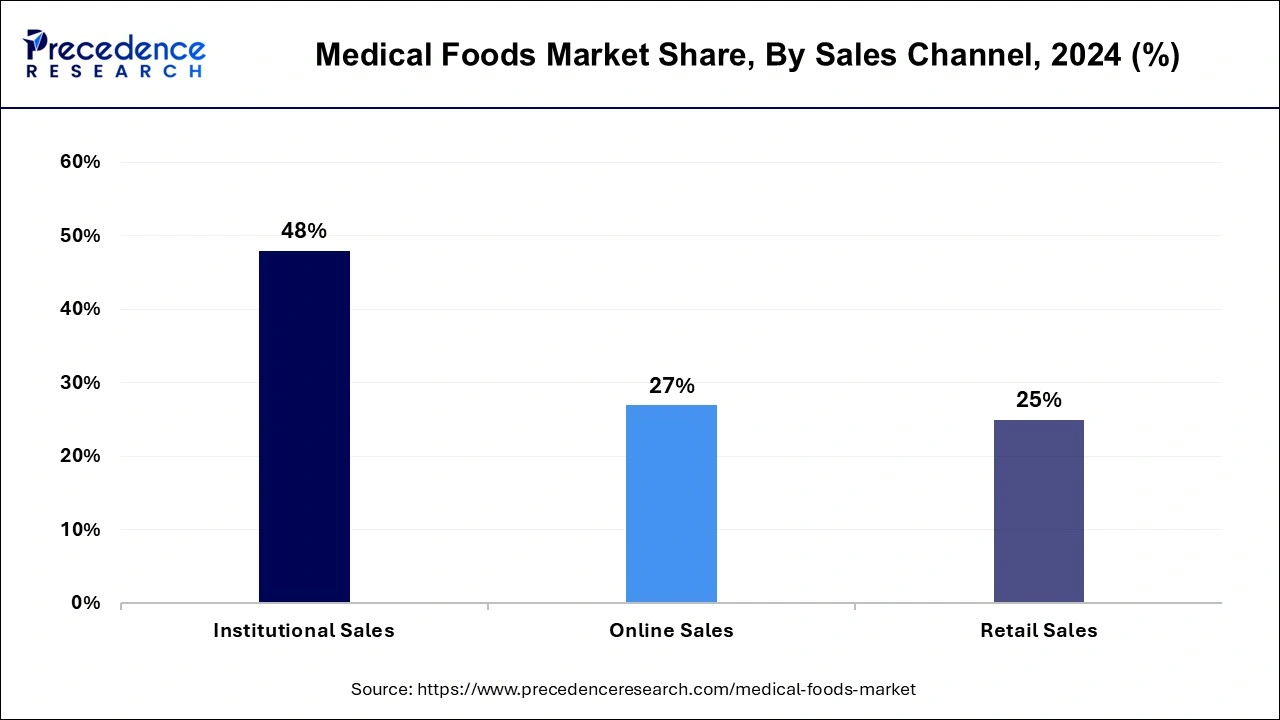
According to sales channels, the online sales segment will be the fastest-growing segment in the medical foods market during the forecast period. Several medical foods are available on websites where one can order medicines online. Online channels provide the luxury of delivery at the doorstep while ensuring the proper quality of the product. Because of online sales, there are no geographical limitations for delivering any product, and a large region can be covered. Online sales are available at any time of the day, and one just has to go on the website to order medical foods. Online sales channels are cheaper and, at the same time, offer a wider reach. Nowadays, online shopping has become very convenient, too, because of the ratings and reviews that people can leave for a product.
By Route of Administration
By Product
By Application
By Sales Channel
By Geography
For inquiries regarding discounts, bulk purchases, or customization requests, please contact us at sales@precedenceresearch.com
No cookie-cutter, only authentic analysis – take the 1st step to become a Precedence Research client
January 2025
March 2025
August 2024
January 2025